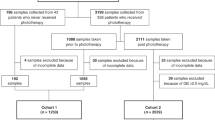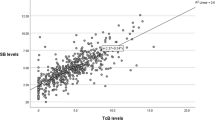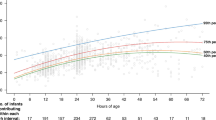Abstract
Background
Elevated albumin-free or unbound bilirubin (UB) levels beyond the first week of life have been associated with the development of bilirubin encephalopathy in preterm infants. However, the mechanism(s) that induces this prolonged unbound bilirubinemia has remained unknown. We hypothesized that it may due to a sustained lower bilirubin-binding affinity of albumin in extremely premature infants.
Methods
Twenty-two very preterm infants born at 28–31 weeks’ gestational age (GA) (VPT Group) and 21 extremely preterm infants born at 22–27 weeks’ GA (EPT Group) were retrospectively studied. On days 14, 21, and 28, bilirubin-binding affinity of albumin was assessed by calculating of the UB/total bilirubin ratio, bilirubin-albumin molar ratio (BAMR), and binding affinity (Ka).
Results
On days 14, 21, and 28, significantly higher UB/total bilirubin ratios were found in the EPT than in the VPT Group. Although BAMRs were comparable, significantly lower Ka values on days 14, 21, and 28 were observed in the EPT than those in the VPT Group (56.1 vs. 70.9 L/μmol, p < 0.001; 55.2 vs. 74.7 L/μmol, p < 0.001; 53.0 vs. 86.5 L/μmol, p < 0.001, respectively).
Conclusions
EPT infants have a sustained lower bilirubin-binding affinity of albumin beyond the first week of life.
Impact
-
Bilirubin encephalopathy is still reported in extremely preterm (EPT) infants.
-
EPT infants often have prolonged unbound bilirubinemia beyond the first week of life.
-
Sustained lower bilirubin-binding affinity of albumin, regardless of the bilirubin-albumin molar ratio (BAMR), is observed in EPT infants.
-
BAMRs should not be used as a surrogate marker of unbound bilirubinemia, especially in EPT infants at a later postnatal period.
This is a preview of subscription content, access via your institution
Access options
Subscribe to this journal
Receive 14 print issues and online access
$259.00 per year
only $18.50 per issue
Buy this article
- Purchase on Springer Link
- Instant access to full article PDF
Prices may be subject to local taxes which are calculated during checkout



Similar content being viewed by others
Data availability
The data that support the findings of this study are available from the corresponding author upon reasonable request.
References
Watchko, J. F. & Tiribelli, C. Bilirubin-induced neurologic damage-mechanisms and management approaches. N. Engl. J. Med. 369, 2021–2030 (2013).
Amin, S. B. Bilirubin binding capacity in the preterm neonate. Clin. Perinatol. 43, 241–257 (2016).
Morioka, I. et al. Disorders of bilirubin binding to albumin and bilirubin-induced neurologic dysfunction. Semin. Fetal Neonatal Med. 20, 31–36 (2015).
Nakamura, H. et al. Auditory nerve and brainstem responses in newborn infants with hyperbilirubinemia. Pediatrics 75, 703–708 (1985).
Meisel, P., Biebler, K. E., Gens, A. & Jaehrig, K. Albumin binding of photobilirubin II. Biochem J. 213, 25–29 (1983).
Abe, S. et al. Bilirubin/albumin (B/A) ratios correlate with unbound bilirubin levels in preterm infants. Pedeatr. Res. 89, 1427–1431 (2021).
Amin, S. B. & Wang, H. Bilirubin albumin binding and unbound unconjugated hyperbilirubinemia in premature infants. J. Pediatr. 192, 47–52 (2018).
Oh, W. et al. Association between peak serum bilirubin and neurodevelopmental outcomes in extremely low birth weight infants. Pediatrics 112, 773–779 (2003).
Okumura, A. et al. A nationwide survey of bilirubin encephalopathy in preterm infants in Japan. Brain Dev. 42, 730–737 (2020).
Morioka, I. et al. Current incidence of clinical kernicterus in preterm infants in Japan. Pediatr. Int. 57, 494–497 (2015).
Okumura, A. et al. Neonatal jaundice in preterm infants with bilirubin encephalopathy. Neonatology 118, 301–309 (2021).
Morioka, I. et al. Serum unbound bilirubin as a predictor for clinical kernicterus in extremely low birth weight infants at a late age in the neonatal intensive care unit. Brain Dev. 37, 753–757 (2015).
Morioka, I. Hyperbilirubinemia in preterm infants in Japan: New treatment criteria. Pediatr. Int. 60, 684–690 (2018).
Nakamura, H. et al. Determination of serum unbound bilirubin for prediction of kernicterus in low birthweight infants. Acta Paediatr. Jpn. 34, 642–647 (1992).
Morioka, I. et al. Clinical kernicterus in preterm infants in Japan. NeoReviews 17, e124 (2016).
Miwa, A. et al. Correlation and precision of serum free bilirubin concentrations determined by single and two peroxidase concentration methods in term or late-preterm newborn infants using a FDA-approved analyzer. Clin. Lab. 58, 507–514 (2012).
Sato, Y. et al. Is bilirubin/albumin ratio correlated with unbound bilirubin concentration? Pediatr. Int. 54, 81–85 (2012).
Miwa, A. et al. Hypoalbuminemia following abdominal surgery leads to high serum unbound bilirubin concentrations in newborns soon after birth. Neonatology 99, 202–207 (2011).
Ichinomiya, K. et al. Problems with using total serum bilirubin as a criterion for phototherapy in extremely low-birthweight infants. Pediatr. Int. 56, 731–734 (2014).
Kono, Y. et al. Developmental assessment of VLBW infants at 18 months of age: a comparison study between KSPD and Bayley III. Brain Dev. 38, 377–385 (2016).
Hulzebos, C. V. & Dijk, P. H. Bilirubin-albumin binding, bilirubin/albumin ratios, and free bilirubin levels: where do we stand? Semin. Perinatol. 38, 412–421 (2014).
American Academy of Pediatrics Subcommittee on Hyperbilirubinemia. Management of hyperbilirubinemia in the newborn infant 35 or more weeks of gestation. Pediatrics 114, 297–316 (2004).
Hulzebos, C. V. et al. The bilirubin albumin ratio in the management of hyperbilirubinemia in preterm infants to improve neurodevelopmental outcome: a randomized controlled trial–BARTrial. PLos One 9, e99466 (2014).
Brodersen, R. & Ebbesen, F. Bilirubin-displacing effect of ampicillin, indomethacin, chlorpromazine, gentamicin, and parabens in vitro and in newborn infants. J. Pharm. Sci. 72, 248–253 (1983).
Amin, S. B. et al. Intravenous lipid and bilirubin-alubumin binding variables in premature infants. Pediatrics 124, 211–217 (2009).
Hegyi, T. et al. Effects of soybean lipid infusion on unbound free fatty acids and unbound bilirubin in preterm infants. J. Pediatr. 184, 45–50 (2017).
Acknowledgements
We are grateful to Dr Ronald J. Wong from the Department of Pediatrics at Stanford University School of Medicine for critical review and valuable suggestions for the improvement of this manuscript. We thank Drs Takao Kobayashi, Shohei Ohyama, Toshihiko Ikuta, Emiko Takeoka, Shoko Tamaki, and Hitomi Mimura at Hyogo Prefectural Kobe Children’s Hospital for their assistance with the manuscript.
Funding
This study was partially supported by a Research Grant from the Ministry of Health, Labour, and Welfare of Japan, grant number 21FC1001 (to S.I.).
Author information
Authors and Affiliations
Contributions
K.H. and S.I. drafted the initial manuscript. K.H., S.I., and H.N. designed and performed the study. K.H., S.I., S.H., A.I., D.K., S.M, and S.Y. collected the clinical data. H.N. and S.Y. supervised the manuscript. All authors approved the final manuscript.
Corresponding author
Ethics declarations
Competing interests
The authors declare no competing interests.
Consent for publication
Written informed consent was received from the parents regarding the use of clinical data for research purposes.
Additional information
Publisher’s note Springer Nature remains neutral with regard to jurisdictional claims in published maps and institutional affiliations.
Rights and permissions
Springer Nature or its licensor (e.g. a society or other partner) holds exclusive rights to this article under a publishing agreement with the author(s) or other rightsholder(s); author self-archiving of the accepted manuscript version of this article is solely governed by the terms of such publishing agreement and applicable law.
About this article
Cite this article
Hirayama, K., Iwatani, S., Nakamura, H. et al. Sustained lower bilirubin-binding affinity of albumin in extremely preterm infants. Pediatr Res 94, 1400–1407 (2023). https://doi.org/10.1038/s41390-022-02418-9
Received:
Revised:
Accepted:
Published:
Issue Date:
DOI: https://doi.org/10.1038/s41390-022-02418-9



